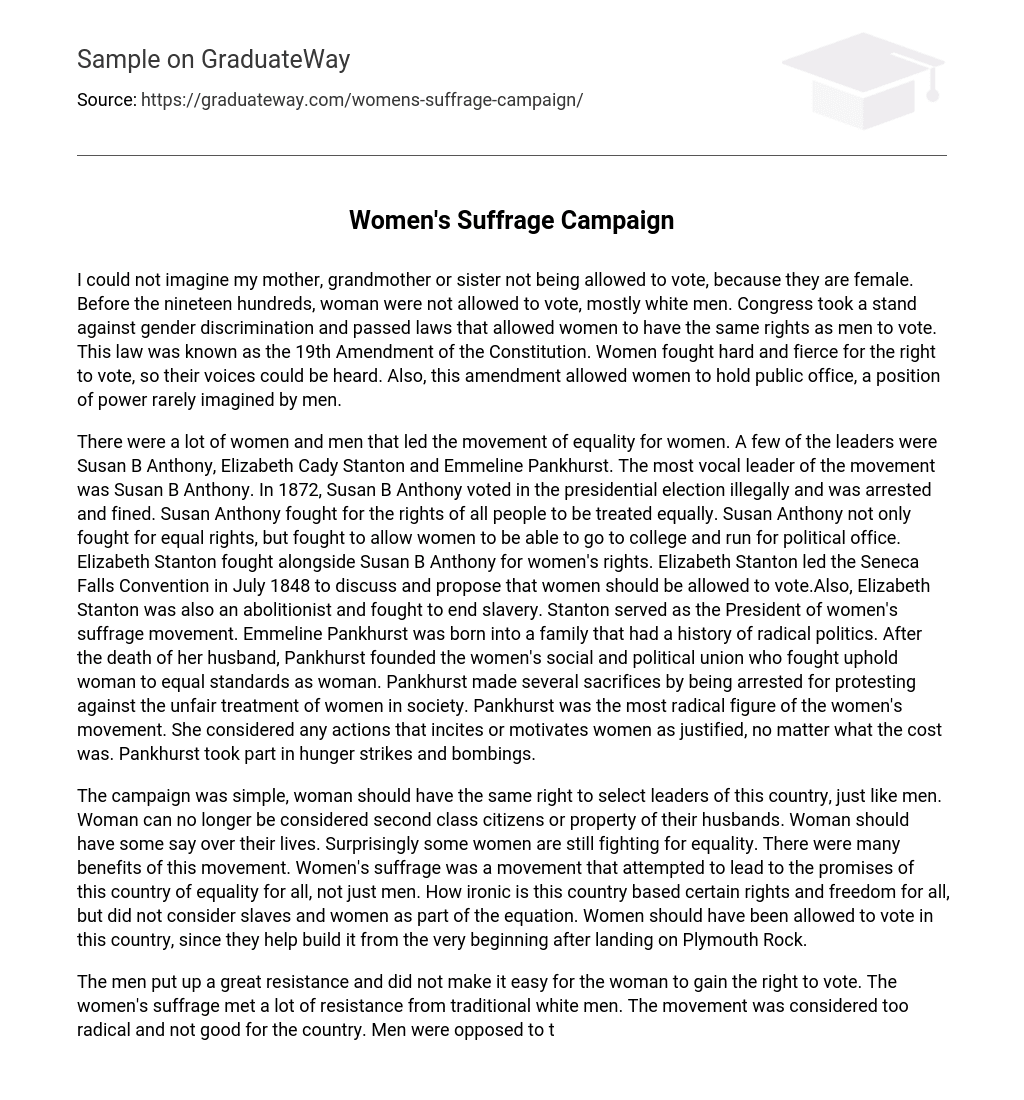I could not imagine my mother, grandmother or sister not being allowed to vote, because they are female. Before the nineteen hundreds, woman were not allowed to vote, mostly white men. Congress took a stand against gender discrimination and passed laws that allowed women to have the same rights as men to vote. This law was known as the 19th Amendment of the Constitution. Women fought hard and fierce for the right to vote, so their voices could be heard. Also, this amendment allowed women to hold public office, a position of power rarely imagined by men.
There were a lot of women and men that led the movement of equality for women. A few of the leaders were Susan B Anthony, Elizabeth Cady Stanton and Emmeline Pankhurst. The most vocal leader of the movement was Susan B Anthony. In 1872, Susan B Anthony voted in the presidential election illegally and was arrested and fined. Susan Anthony fought for the rights of all people to be treated equally. Susan Anthony not only fought for equal rights, but fought to allow women to be able to go to college and run for political office. Elizabeth Stanton fought alongside Susan B Anthony for women’s rights. Elizabeth Stanton led the Seneca Falls Convention in July 1848 to discuss and propose that women should be allowed to vote.Also, Elizabeth Stanton was also an abolitionist and fought to end slavery. Stanton served as the President of women’s suffrage movement. Emmeline Pankhurst was born into a family that had a history of radical politics. After the death of her husband, Pankhurst founded the women’s social and political union who fought uphold woman to equal standards as woman. Pankhurst made several sacrifices by being arrested for protesting against the unfair treatment of women in society. Pankhurst was the most radical figure of the women’s movement. She considered any actions that incites or motivates women as justified, no matter what the cost was. Pankhurst took part in hunger strikes and bombings.
The campaign was simple, woman should have the same right to select leaders of this country, just like men. Woman can no longer be considered second class citizens or property of their husbands. Woman should have some say over their lives. Surprisingly some women are still fighting for equality. There were many benefits of this movement. Women’s suffrage was a movement that attempted to lead to the promises of this country of equality for all, not just men. How ironic is this country based certain rights and freedom for all, but did not consider slaves and women as part of the equation. Women should have been allowed to vote in this country, since they help build it from the very beginning after landing on Plymouth Rock.
The men put up a great resistance and did not make it easy for the woman to gain the right to vote. The women’s suffrage met a lot of resistance from traditional white men. The movement was considered too radical and not good for the country. Men were opposed to the protests and hunger strikes by woman. Some women resorted to violence to get their point across. These negative things took away from the main issue of equality. This issue drove a wedge between marriages where women had to choose between their husbands or individual rights for women.
If I lived in those times, as a free white man, would I agree or disagree with allowing women the right to vote? Basically allowing a woman to vote would not take away any of my power. All Americans should be allowed to vote regardless of your race or gender, because this country was founded on the principles that all men are created equal. How could I love my wife but not allow her to vote, because she is a woman. I would not want my children to think I was a hypocrite allowing my son to vote, but not my daughter.
Works Cited
- Steele, Philip. Eyewitness Vote. Dk Pub, 2008.
- “Womens Suffrage.” History.com, A&E Television Networks, 28 Oct. 2008, www.history.com/topics/womens-history/the-fight-for-womens-suffrage.
- “Civil Rights.” Ducksters Educational Site, www.ducksters.com/history/civil_rights/womens_suffrage.php.
- “19th Amendment.” History.com, A&E Television Networks, 5 Mar. 2010, www.history.com/topics/womens-history/19th-amendment-1.
- “The Woman Suffrage Movement.” National Women’s History Museum, www.womenshistory.org/resources/general/woman-suffrage-movement.





